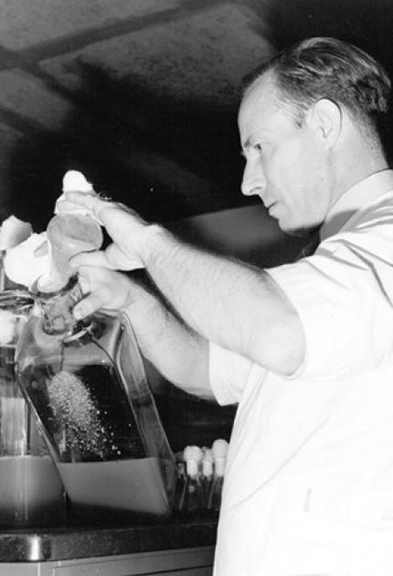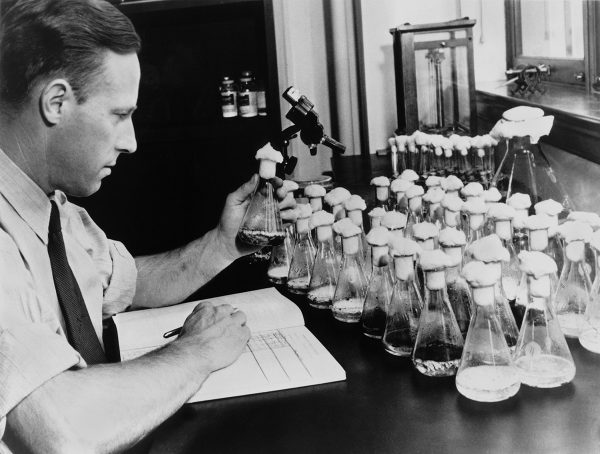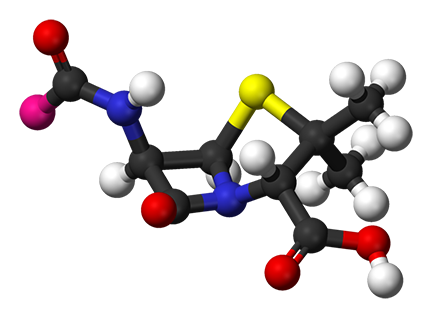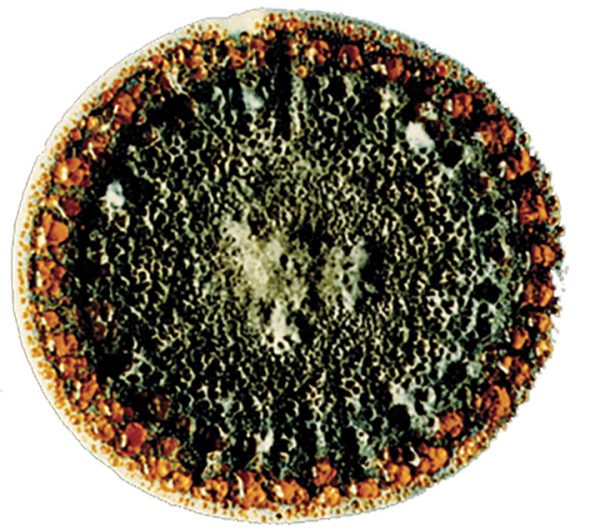 Submitted by Brian Capouch
Submitted by Brian Capouch
Andrew Jackson Moyer was born in 1899 near Star City. He was the son of Edward R. and Minnie McCloud Moyer. He went to Wabash College, then pursued a career as a microbiologist. He led the development of a method of mass-producing the greatest wonder drug of all time, penicillin. His invention is credited with saving the lives of countless people, including an estimated 10-15% of the soldiers who were injured in World War II.
There is a Wikipedia page about him, just one of many resources. His mother died when he was only a toddler, and after her death he moved in with a neighboring family, the Osborns. When he was 15 he joined his remarried father in Logansport. During his time at Wabash he was a member of the Army’s Student Training Corps. He did graduate work at the University of Wisconsin, where he worked with two professors who introduced him to what became the passion of his life, microbial nutrition. In 1929 he finished a PhD in plant pathology at the University of Maryland and was hired by the USDA. In 1940 he joined his mentor, Dr. Orville May, the director of the new Northern Research Laboratory (NRL) in Peoria, Illinois.

Penicillin was discovered in 1928 by Alexander Fleming of Scotland. As World War II loomed scientists had no way to mass produce the drug. An anecdote relates that at one point half of the world’s supply was consumed in order to successfully treat a single patient.
 In 1941, two British scientists from Oxford University, professors Howard Florey and Norman Heatley, brought a small sample of penicillin to the NRL with the goal of mass producing it. During their time there, the fortuitous (and very famous) discovery of a rotting cantaloupe in a garbage can in Peoria led to a dramatically potent new strain of the drug.
In 1941, two British scientists from Oxford University, professors Howard Florey and Norman Heatley, brought a small sample of penicillin to the NRL with the goal of mass producing it. During their time there, the fortuitous (and very famous) discovery of a rotting cantaloupe in a garbage can in Peoria led to a dramatically potent new strain of the drug.
 Moyer and the British scientists developed a method of producing mass quantities of the strain, which had the dual benefits of saving many lives and reducing the cost of a dose from around $20 to about 50 cents.
Moyer and the British scientists developed a method of producing mass quantities of the strain, which had the dual benefits of saving many lives and reducing the cost of a dose from around $20 to about 50 cents.
Florey and Heatley returned to England by early 1942, and shortly thereafter Moyer published a paper about the process they developed, without giving credit to the Oxford scientists. They publicly accused him of failing to acknowledge their contributions to his work. A transcontinental controversy erupted following the war, after Moyer obtained a series of patents for the process they developed.
 Moyer and others at the ARL stood accused of unethical behavior. The drug companies which went on to produce penicillin in vast quantities refused to pay Moyer any royalties. Fleming, Florey, and Dr. Ernst Chain received the Nobel Prize in 1945 for their work with penicillin. Many articles which talk about the commercial development of the drug make no mention of Moyer’s contributions.
Moyer and others at the ARL stood accused of unethical behavior. The drug companies which went on to produce penicillin in vast quantities refused to pay Moyer any royalties. Fleming, Florey, and Dr. Ernst Chain received the Nobel Prize in 1945 for their work with penicillin. Many articles which talk about the commercial development of the drug make no mention of Moyer’s contributions.
Moyer retired from the USDA in 1957 and passed away two years later at age 59. He was posthumously named to the National Inventors Hall of Fame, the first government researcher ever to be so honored. His widow endowed a scholarship in his name at the University of Maryland, where they met.

Footnotes from the Editor:
On May 25, 1948, Andrew J Moyer was granted a patent for a method of the mass production of penicillin.
In 1987, Moyer was posthumously named to the National Inventors Hall of Fame in Arlington, Virginia. There he joined such luminaries as Thomas Edison, Luther Burbank, and the Wright brothers. Dr. Andrew Jackson Moyer was the first Government researcher ever to be inducted.